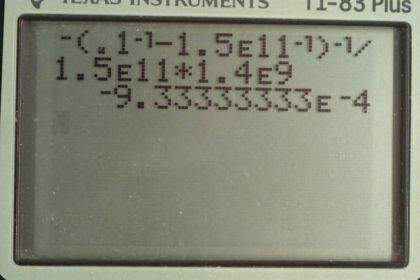Question
A camera with a 100 mm focal length lens is used to photograph the sun and moon. What is the height of the image of the sun on the film, given the sun is in diameter and is away?
Final Answer
Solution video
OpenStax College Physics for AP® Courses, Chapter 25, Problem 51 (Problems & Exercises)

vote with a rating of
votes with an average rating of
.
Calculator Screenshots
Video Transcript
This is College Physics Answers with Shaun Dychko. We're going to figure out what is the height of an image of the Sun, given a lens with focal length 100 millimeters. The Sun's distance is 1.5 times ten to the 11 meters away and the Sun has a diameter which we’ll take as the object height of 1.4 times ten to the nine meters. So I converted kilometers into meters and I converted this millimeters into meters. So to figure out the height, we'll need to figure out the magnification and then multiply that magnification by the object height to then figure of the image height. But to find the magnification, we need to know what the image and object distances are and then define the image distance, we need to use this thin lens equation. So let's start here. We're going to subtract one over the object distance from both sides and we get one over image distance equals one over focal length minus one over object distance. So then take both sides to the power of negative one. And we get image distance is the reciprocal of the difference in the reciprocals. So instead of writing fractions one over f , you can instead write f to the Power of Negative one if you prefer. And so after the negative one minus object distance to the negative one, all to the negative one is the image distance. So this image distance is what we substitute for di in our magnification formula. So magnification is negative of image distance divided by object distance and we substitute f to the negative one minus d naught to the negative one, all to the negative one in place of di. And then we're going to figure out the image height of the sun and we’ll multiply both sides of this version of the magnification formula by object's height and we have image height is magnification times object height and we have this expression here for magnification. So we substitute that in for m and multiply it all by h naught. So the image height then is negative of 0.1 meters focal length to the negative one minus one and a half times ten to the 11 meters object distance to the negative one, all to the negative one times the object height of 1.4 times ten to the nine meters all divided by the object distance of 1.5 times ten to the 11 meters. And we get this height which is negative 0.933 millimeters.
